Back on Track: WCN's Campaign to Improve Europe's Cross-border Trains
Rendezvous on Champs-Elysees... Leave Paris in the morning on T.E.E.
In Vienna we sit in a late-night café... Straight connection, T.E.E.
So sang Kraftwerk in their 1977 masterpiece Trans-Europe Express, but there are no direct trains on this route today. And bad luck if you want to travel between Paris and Munich, Berlin or Hamburg: overnight trains were axed in December 2014. Read on if you want to know why and what could be done to stop the deterioration of Europe's international passenger train network...
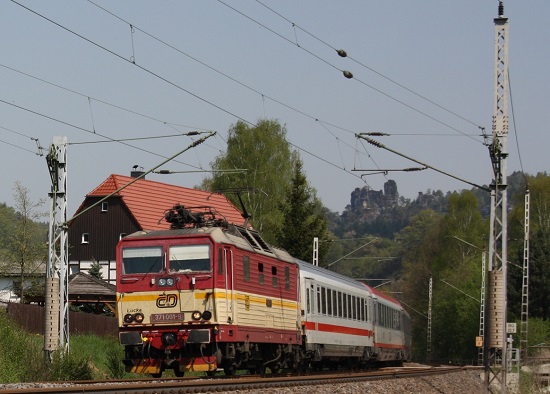
Background
Europe has long benefitted from a dense rail network, including many cross-border routes that have traditionally been operated in a spirit of cooperation between neighbouring national railway companies. Today, however, the passenger rail network as a whole is slowly contracting, including the loss of both regional cross-border and direct long-distance international routes.
Cross-border trains are under particular threat for a variety of reasons, including lower demand and higher operating costs (than equivalent domestic routes), poor management and domestic and EU-level politics, compounded by the economic crisis. In recent years passengers have faced line closures, timetable cuts (including the loss of direct long-distance trains), poor connections, ticketing difficulties and insufficient information provision, prompting World Carfree Network to launch Back on Track at the end of 2012. Our aim is to raise awareness of cross-border rail problems, highlight solutions and encourage positive intervention at the national and European levels, while supporting other groups with their own regional pro-rail campaigns.
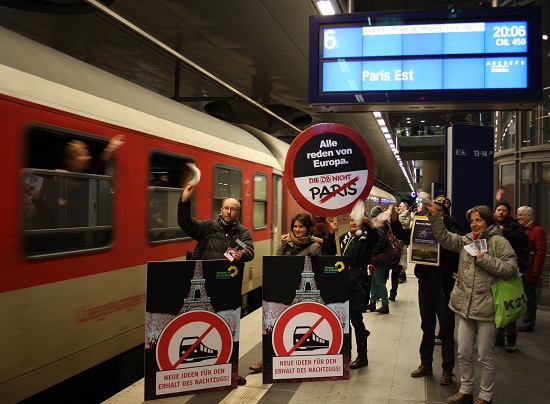
News
Night trains in western Europe: the following new or reinstated routes were announced at a joint press conference of the German, Austrian, Swiss and French transport ministers and incumbent train operators on 2 December 2020:
From December 2021:
- Zürich – Amsterdam
- Wien – Paris
From December 2022:
From December 2023:
- Berlin – Paris
- Berlin – Brussels
From December 2024:
Croatia - Slovakia - Czech Republic: at very short notice, open access operator RegioJet launched a thrice-weekly Rijeka - Ljubljana - Bratislava - Brno - Praha overnight service in summer 2020 and, thanks to its success, later increased frequency to daily. This shows what can be done where there's a will, even for a train running through five countries!.
News Archive
December 2020 Timetable Change
Please note that this list is to the greatest extent possible based on the planned timetables for 2021 and does not attempt to document every short-term change arising from the COVID-19 pandemic. As of 1 December 2020 the EU's external borders were effectively closed, meaning no passenger trains or through carriages between EU member states and Ukraine/Belarus/Russia until further notice.
Good news:
- Austria - Belgium: from the end of March 2021 night train connections between Vienna and Liège/Brussels increase in frequency from twice to three times per week, with arrival in Brussels one hour earlier and departure from there almost 1.5 hours later, a massive improvement!
- Austria - Croatia: a twice-weekly summer night train with car-carrying wagons will run on the Wien - Zagreb - Split route between mid June and mid September 2021.
- Austria - Czech Republic: the four train pairs on the Praha - České Budějovice - Linz route gain bistro cars and thus EuroCity status.
- Austria - Germany: with the introduction of frequent, electric trains on the München - Zürich route, the service between Bregenz and München is doubled to six times per day (every two hours with one gap).
- Austria - Hungary: from some time in early 2021, the last remaining gaps in the Wien - Budapest timetable will be filled by three additional train pairs, creating an hourly service throughout the day.
- Austria - Italy: the EuroCity Emona between Vienna and Ljubljana should convey through carriages to/from Trieste in Italy from 3.5.2021, the first long-distance international train service on this route for many years.
- Austria - Netherlands: from the end of March 2021 a daily night train will operate between Wien and Utrecht/Amsterdam. On selected dates through carriages will run between Innsbruck and Utrecht/Amsterdam.
- Austria - Romania: the portion of the EuroCity service Transilvania between Wien and Satu Mare is extended to/from Baia Mare.
- Austria - Slovakia: one pair of regional trains on the Bratislava-Petržalka - Wien route is extended to/from Semmering and Mürzzuschlag at weekends.
- Austria - Switzerland: with the introduction of frequent, electric trains on the München - Zürich route, the service between Bregenz and Zürich is doubled to six times per day (every two hours with one gap).
- Belarus - Poland - Czech Republic - Slovakia - Hungary: the EuroCity train pair Bathory Terespol - Warszawa - Katowice - Ostrava - Břeclav - Bratislava - Budapest (with through carriages to/from Olomouc, Pardubice and Praha) is extended to start/end in Brest in Belarus.
- Belgium - Germany: night train connections between Passau/Nürnberg and Liège/Brussels increase in frequency from twice to three times per week from March 2021, with arrival in Brussels one hour earlier and departure from there almost 1.5 hours later.
- Croatia - Czech Republic: following the success of services in summer 2020, it is expected that RegioJet will operate direct overnight trains on the Rijeka - Bratislava - Praha route over a longer period in summer 2021.
- Croatia - Slovakia:
- following the success of services in summer 2020, it is expected that RegioJet will operate direct overnight trains between Rijeka and Bratislava route over a longer period in summer 2021.
- a twice-weekly summer night train with car-carrying wagons will run on the Bratislava - Wien - Zagreb - Split route between mid June and mid September 2021.
- Czech Republic - Poland:
- EuroCity trains Praha/Břeclav - Bohumín - Kraków are accelerated significantly between Katowice and Kraków.
- the EuroCity train pair Cracovia Praha - Ostrava - Kraków is extended to/from Przemysl.
- RegioJet has indicated it plans to launch an overnight train pair Praha - Ostrava - Kraków - Przemysl from sometime in spring 2021.
- a new train pair Bohumín - Lublin is introduced, presumably as a way of getting the CD rolling stock hired by PKP InterCity back to the Czech Republic for maintenance. In July and August this train conveys a portion to/from Zamosc.
- Czech Republic - Slovenia: following the success of services in summer 2020, it is expected that RegioJet will operate direct overnight trains on the Praha - Bratislava - Ljubljana - Rijeka route over a longer period in summer 2021.
- Germany - Poland: the daily EuroCity Wawel Berlin - Wrocław - Kraków returns after an absence of six years, complete with restaurant car.
- Germany - Sweden: as a reaction to the resurgence of rail travel in Sweden/by Swedes since 2019, Snälltåget's Berlin - Malmö trains will run twice a week from the end of March until the beginning of October 2021 and daily from mid June to the the beginning of September 2021, as well as being extended to/from Stockholm. These trains will feature couchette cars recently purchased from DB as well as a restaurant car on the Swedish section north of Malmö. All trains will run overland via Denmark instead of via the now-withdrawn Trelleborg - Sassnitz ferry.
- Germany - Switzerland: frequency on the München - Zürich route is doubled to six daily train pairs. Electric trains now run every two hours (with one gap) and with an improved end to end journey time of around four hours.
- Great Britain - Netherlands: having finally started operating at the end of October 2020, up to three daily direct Amsterdam - Rotterdam - London trains become a fixture of the Eurostar timetable.
- Hungary - Poland: the through carriages of the EuroCity train pair Bathory Budapest - Bratislava - Břeclav - Ostrava - Katowice - Kraków are extended to/from Przemysl.
- Hungary - Serbia: at least according to the SrbijaVoz timetable, two train pairs between Budapest and Kelebia run across the border once again to/from Subotica, for onward rail connections to/from Novi Sad. This is arguably an improvement on the previous situation of only one train pair per day on the cross-border section in the form of a Kelebia - Novi Sad service. Anyone wanting to travel to/from Belgrad is best advised to take a domestic long-distance bus service to/from Subotica.
- Italy - Slovenia: a new EuroCity service with through carriages to/from Wien (as part of the Emona) will operate between Trieste and Ljubljana from 3.5.2021, the first comfortable long-distance international train service on this route for many years. This service complements the recently introduced regional services between Ljubljana and Trieste.
- Italy - Switzerland: Milan - Zurich trains are accelerated by about 20 minutes thanks to the Ceneri Base Tunnel, with frequency boosted from six to ten daily train pairs.
- Lithuania - Poland: the regional service Kaunas - Šeštokai - Białystok is increased in frequency from previously Fridays - Mondays to one train pair daily. There may be a connecting service to/from Vilnius.
- Poland - Slovakia: the through carriages of the EuroCity train pair Bathory (Budapest -) Bratislava - Břeclav - Ostrava - Katowice - Kraków are extended to/from Przemysl.
- Slovenia - Slovakia: following the success of services in summer 2020, it is expected that RegioJet will operate direct overnight trains on the Ljubljana - Bratislava (- Praha) route over a longer period in summer 2021.
Back to Current News
News Archive
Nice try, but it's a fail...
In this section we highlight announcements that have not come to fruition as well as massive infrastructure investments that have somehow not led to the service improvements you would expect.
- Austria - Denmark - Sweden: as a reaction to the resurgence of rail travel by Swedes since 2019, Snälltåget had planned to launch a weekly ski train between Malmö and Zell am See/Bischofshofen via Denmark and Germany, operating on a total of five winter weekends in early 2021. However, in early December 2020 the operator announced that all trains had been cancelled owing to COVID-19.
- Bulgaria - Turkey: despite the completion of most upgrade work on the Bulgarian side of the border as well as in the suburbs of Istanbul, the single Sofia - Plovdiv - Istanbul train pair - with passport control at 02:00 in the morning on the platform in Kapikule - remains the only cross-border service on the line. What a waste of millions of Euros of infrastructure funding...
- Hungary - Slovakia: Budapest - Košice services were shown in a draft version of the ZSSK timetable as being boosted from two to seven train pairs, providing a two-hourly regular interval service. What happened to this proposal?
- Kosovo - North Macedonia: the Skopje - Han i Elezit - Pristina train pair has reappeared in the SrbijaVoz printed timetable, but all reports suggest it actually remains 'suspended' (since October 2018).
- Lithuania - Poland: a Kaunas - Białystok - Warsaw TLK/IC train pair with connections to/from Vilnius was expected to be introduced in the second half of 2021, a mere 4.5+ years later than originally announced by PKP InterCity. However, as of mid January 2021 it seems this has been postponed once again!
Back to Current News
Bad news:
- Austria - Belgium: the direct night train connection between Innsbruck and Brussels no longer runs.
- Austria - Russia: the weekly night train between Nice and Moscow via Innsbruck and Wien remains withdrawn until further notice, presumably meaning until a Covid-19 vaccine has become widely available and taken up. But will it ever return...?
- Belgium - Germany: there is no longer a direct night train connection between Brussels and München.
- Czech Republic - Germany: it appears that there will be no trains at all over the border crossing Vejprty - Cranzahl, with the summer weekend service on the Czech side running only as far as Vejprty.
- Czech Republic - Slovakia: "suspended" since December 2019, Arriva's weekends-only direct services between Praha, Trenčín and Nitra are now permanently withdrawn.
- Estonia - Latvia: as a result of changes to Estonian domestic timetables there will no longer be any useable train connections at all between Tallinn and Riga via the border town of Valga. Although direct services were withdrawn many years ago, until 12 December 2020 there was at least one daily connection in each direction with a short wait in Valga between connecting trains.
- France - Great Britain: there will be no direct Eurostar trains between London and Lyon/Avignon/Marseille in 2021.
- France - Italy:
- Thello's Marseille - Nice - Genova - Milan service of up to three daily EuroCity train pairs is reduced to one train pair after the festive period December 2020 - January 2021. From March 2021 there is as yet no timetable available. Hopefully this is merely a Corona-related service reduction.
- Thello's Paris - Venice overnight service is withdrawn until further notice, ostensibly owing to Corona.
- France - Russia: the weekly night trains on the Nice - Genova - Wien - Moscow and Paris - Berlin - Moscow routes remain withdrawn until further notice, presumably meaning until a Covid-19 vaccine has become widely available and taken up. But will they ever return...?
- Germany - Russia: the thrice-weekly night trains between Berlin and Moscow remain withdrawn until further notice, presumably meaning until a Covid-19 vaccine has become widely available and taken up.
- Germany - Poland:
- the weekends-only Berlin - Wrocław Kulturzug (culture train) is suspended until further notice (but see good news item above about the EuroCity Wawel).
- on the Berlin - Kostrzyn route, buses replace all trains between Küstrin and Kostrzyn for two years owing to the replacement of the bridge over the river Oder/Odra.
- North Macedonia - Serbia: There will be no direct trains on the Belgrad - Niš - Skopje - Gevgelija route in 2021, ostensibly owing to track repair work on the Niš - Preševo section in Serbia.
- Poland - Slovakia: the daily overnight TLK train pair between Gdynia and Žilina is once again cut back to Bielsko Biala, meaning the Zwardoń/Čadca border crossing loses its long-distance trains again after just one year.
Countries completely cut off by rail
In this section we list countries that are completely cut off from their neighbours, i.e. countries with rail networks but no year-round international passenger trains.
- Albania: this country has never been served by international pasenger trains despite the existence since 1986 of a line between Shkodër and Podgorica (Montenegro), used by occasional freight trains.
- Bosnia: no international trains since the withdrawal of the Sarajevo - Zagreb train pair in December 2016.
- Greece: trains have not run between Gevgelija (North Macedonia) and Thessaloniki since 17 October 2017, but the single train pair was at least replaced by buses. However, even the bus now no longer operates outside of the high summer season (mid June - mid September). Over on the border crossing between Greece and Bulgaria, the daily daytime train pair between Thessaloniki and Sofia via Strimon and General Todorov ceased on 25 May 2017. A replacement bus has operated between Strimon and Kulata since then, seemingly linked to the decision of TrainOSE to use non-standard rolling stock on the Thessaloniki - Alexandroupolis service, which can therefore no longer convey through carriages to/from Sofia. This leaves Greece with no international trains at all for most of the year; between 7 June and 4 October 2020 there is a weekly train between Thessaloniki and Bucharest, running overnight between Thessaloniki and Sofia.
- North Macedonia: The Belgrade - Niš - Skopje - Gevgelija night train pair was 'temporarily suspended' from 30 September 2018 and in 2019 only ran in summer (14 June - 15 September). In 2021 there will be no service at all, ostensibly down to track repair work on the section Niš - Preševo in Serbia. Similarly, it is reported that as of October 2018 the Skopje - Han i Elezit (- Pristina) train pair is 'temporarily suspended' without bus replacement. All this means the country is no longer reachable from its neighbours by rail.
News Archive
Why is Rail Worth Saving?
Trains can offer safe, fast and low-carbon mobility for all, reducing the environmental impact of travel significantly. On average, rail produces only 25% and 30% of the per passenger km carbon emissions of planes and cars respectively, based on average occupancy figures. These figures do not include the additional climate change impacts of emissions at altitude: aviation figures should be multiplied by a 'radiative forcing index' of between 1.9 and 2.7. Note also that GHG emissions from rail are even lower in countries with a high proportion of renewable electricity generation, including Sweden and Switzerland with their abundant hydro-electric power and almost zero-carbon rail operations.
Trains offer direct city centre to city centre travel and allow passengers to use their on-board time productively. Many people simply enjoy the experience of watching Europe passing their window seat... we often wonder why most railway companies do not follow the lead of Switzerland in actively promoting the comfort and pleasure of rail travel!

Towards Carfree Cities IX conference participants enjoy a networking opportunity en route from York to a study tour in Newcastle, courtesy of Grand Central. Although this company is a private 'open access' operator, ticketing is integrated into Britain's national system: we regard this as both passenger-friendly and a sensible long-term business model.
Without railways, there would be many more cars and trucks on Europe's roads, leading to increased congestion, air pollution, fossil fuel consumption, reliance on energy imported from politically unstable parts of the world, noise and accidents (9 people die every day on British roads, considered to be among the safest in the EU). Without Europe's dense network of passenger train routes, how would you get around? Would you buy a car, fly more and/or suffer slow long-distance bus journeys? Or hitchhike...? Would your want to live in your city if it becomes overrun with even more motor vehicles?
What Has Gone Wrong and Why?
European and national transport policy favours aviation. Flight tickets and aviation fuel remain largely untaxed, representing a huge subsidy and making it very difficult for rail to compete on price.
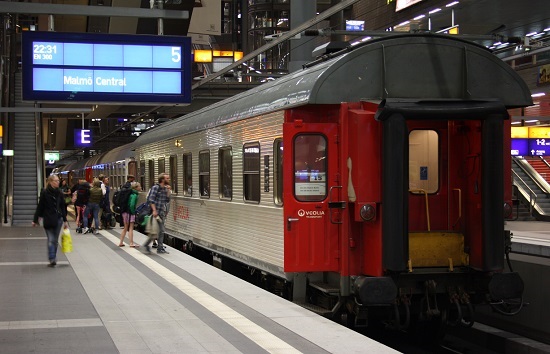
In the early 1990s German and Swedish Railways cooperated in the operation of three daily train pairs between Prague/Dresden/Berlin and Malmö in Sweden. Thanks to the European Commission's liberalisation of aviation, the train became unable to compete with undertaxed low-cost flights on price. A vicious circle of falling passenger numbers and service cuts followed, culminating in first DB, then SJ, pulling out of its operation. Since being taken over by the private operators Veolia and GVG in 2012, the remaining Berlin - Malmö service runs 2-3 times per week and without sleeping cars in the short Swedish high summer only. We are of course grateful to the operator for continuing to participate in the InterRail scheme, one of very few 'open access' operators to do so.
European and national transport policy favours road transport. The European Commission and national governments continue to drag their heels over the implementation of 'user pays' and 'polluter pays' principles for private car use, putting rail at a competitive disadvantage. The road freight industry covers only 60% of the environmental and infrastructure damage it causes, representing another perverse subsidy, while around two thirds of trucks are operated illegally in some way (exceedance of maximum permitted driving hours, overloading, etc). Maximum permitted truck weights continue to be raised across the EU, the Commission having somehow been persuaded by the road haulage lobby that 'supertrucks' will lead to fewer truck movements! Of course it does no such thing and simply undermines the economic viability of rail freight, especially the 'wagonload' market. If rail freight disappears from a particular route, passenger trains then have to bear all the infrastructure maintenance costs.
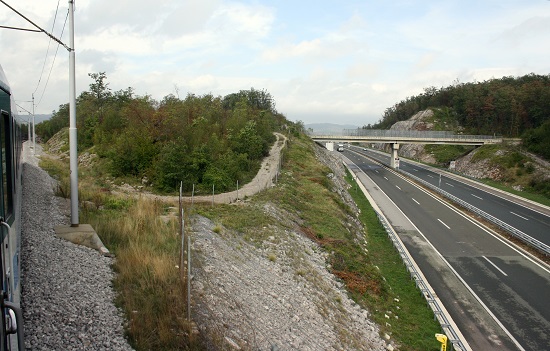
A Rijeka (Croatia) - Ljubljana (Slovenia) - Wien (Austria) train climbs out of Rijeka in October 2012. Croatian Railways (HZ) announced that the entire Croatian section of the route would lose its passenger trains in December 2012, on the eve of the country's accession to the EU, but WCN's petition helped to persuade HZ to reverse this decision. Within Croatia this line is extremely slow, raising questions as to why speeds were not increased during recent (EU co-financed) work to change the electrification system. In contrast, the parallel road has been lavishly upgraded, undermining the economic viability of the railway. Such scenes can be seen across vast swathes of central and southern Europe.
European policy favours road infrastructure projects, and infrastructure spending in general over financial support for operations. European funding institutions have demanded cuts to public transport funding in many countries during the economic crisis. Motorways and other trunk roads continue to be built and upgraded across the continent, despite the known negative environmental and social consequences, thanks in part to co-financing from the EU's Cohesion and Structural funds, especially in central, eastern and southern Europe. In contrast, parallel rail infrastructure is frequently neglected. This damaging policy background undermines other EU-level transport policy and environmental objectives. Greece stopped running international passenger trains in March 2011 (since partially reinstated in May 2014) and has closed many domestic routes, including lines recently upgraded with EU money! White elephant motorways and airports continue to be built...
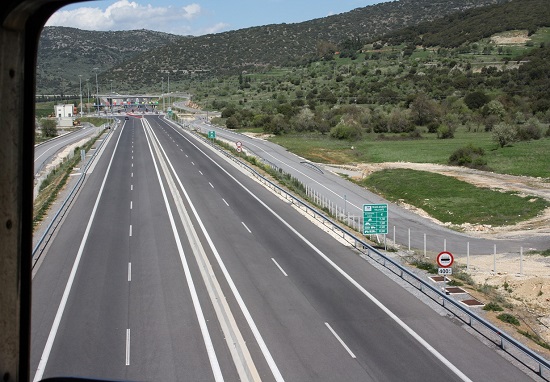
A hugely expensive and hardly used new toll road in the Greek Peloponnese, as seen from a charter train on the Korinthos - Tripolis - Kiparissia line in April 2013, a railway that was modernised with EU money in 2006 but lost all its trains in 2011. No, we are not joking! Public transport disappeared almost overnight, leaving passengers with a choice of the car or staying at home. We wonder how the EC's noble modal shift goals - including a target for rail to account for half of all medium-distance journeys by 2050 - will be achieved if this trend continues?
The nature of demand, domestic politics and institutional barriers. Transport is often low on the list of political priorities. Railways come even lower, while there are few votes to be had from improving cross-border railways, where demand is generally lower than on equivalent domestic routes owing to language and cultural barriers. At a time of economic recession, governments tend to look for easy targets for spending cuts, especially when European institutions add to this pressure. In most cases there are genuine additional operating costs associated with international rail routes, while funding/contract mechanisms each side of the border are often incompatible. It is for these reasons that WCN has called for EU funding specifically for the operation of cross-border passenger trains, possibly by means of Public Service Obligation contracts. Disputes between neighbouring countries can also lead to worse cross-border services, something that is clearly not in the broader interest of the 'single market'.
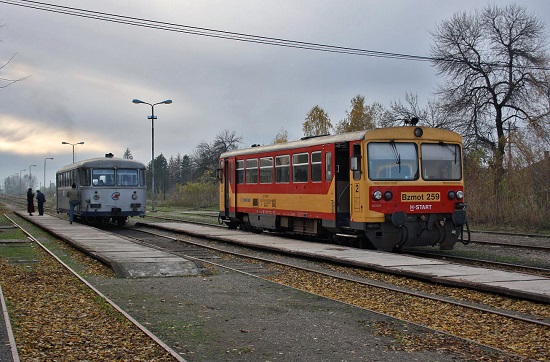
Until a few years ago there were direct trains between Szeged (Hungary) and Subotica (Serbia). Each railway then decided to ban the trains of the other country, for reasons that remain unclear. Passengers are now forced to change trains at the extremely basic border station of Horgoš (pictured). Patronage has dwindled to the extent that these elderly railcars can handle the limited traffic that remains. Update: in the wake of Europe's refugee crisis, the route between Röszke and Horgoš was physically severed in September 2015.
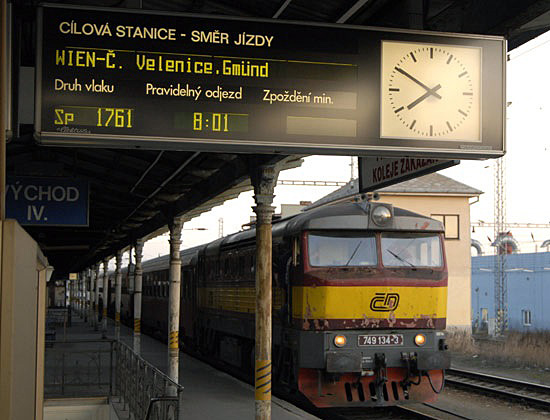
Direct trains were provided between České Budějovice and Vienna until the partially EU-financed electrification of this route on the Czech side was completed. Instead of celebrating this modernisation, we find ourselves wondering why the service has deteriorated.
Image courtesy of Al Pulford.
Case study: Baltic States: since the end of May 2015 there are almost no international passenger trains within the Baltic States, while the Vilnius - Warsaw train remains "suspended until further notice". An entire region of the EU cut off from central Europe - how did it come to this? It remains to be seen whether the Via Baltica project, predominantly intended as freight corridor, will bring improvements.
- Estonia - Latvia: weekday engineering works in Latvia between February and May 2015 caused broken connections in Valga on the Tallinn - Riga route, a situation repeated from 1 June 2016.
- Estonia - Russia: From 15 February 2015 the private Go Rail service of two daily train pairs between Tallinn and St. Petersburg was reduced to two per WEEK. From 12 May 2015 there were no passenger trains at all on this route, with Tallinn - Moscow also withdrawn from 19 May 2015. A daily Tallinn - St. Petersburg - Moscow service operated by Russian Railways then resumed on 10/11 July 2015. More information here.
- Lithuania - Latvia - Russia: since 31 May 2015 there are no passenger trains between Lithuania and Latvia, following the withdrawal of the Vilnius - St. Petersburg night train.
- Poland - Lithuania: a new weekends-only service of 1-2 train pairs between Białystok and Mockava was introduced on 17 June 2016. Unfortunately their average speed is just 50 km/h, much slower than competing buses.
Management, incentives and conflicts within the rail sector. Although far from perfect by any means, national long-distance rail operators have traditionally cooperated with their neighbours in the areas of timetabling and ticketing, culminating in the EuroCity network that peaked in the early 1990s. This has dwindled in recent years as railways have focussed on their core domestic markets, often in readiness for additional competition from 'open access' operators and/or a desire for profit maximisation. We suspect many railways do not understand the potential size of the market for long-distance international rail travel, which they assume to be too small to be worth developing, despite passengers' increasing desire for a more relaxed and environmentally friendlier alternative to the modern-day air travel experience.
Incumbent operators in Italy, Germany and elsewhere have reacted extremely badly to the threat of competition from their neighbours, resulting in the total loss of cooperation (marketing, through/inter-available ticketing between operators, ticket sales, optimal connections, passenger rights, etc.) in some cases. This is very bad news for passengers who - rightly or wrongly - regard 'the railway' as a single system, something that should be hailed as a great strength in comparison with the fragmented aviation and long-distance bus sectors!
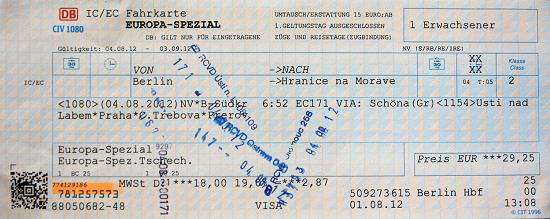
High track and station access charges have killed off many marginal routes in recent years, despite supposedly being limited by European-level legislation to the recovery of marginal costs. A high-profile example is the excessive cost of infrastructure use in Belgium, which led to the gradual withdrawal of all overnight trains to/from/via the country, the last to survive being the (Paris -) Brussels - Berlin/Hamburg train, binned in December 2008. Until their complete withdrawal in December 2014, City Night Line trains from Paris to Germany had to take a much longer route through France, while journeys to/from London took far too long and were more expensive, a double whammy for the poor passenger and highly damaging for the economics of night train operations.
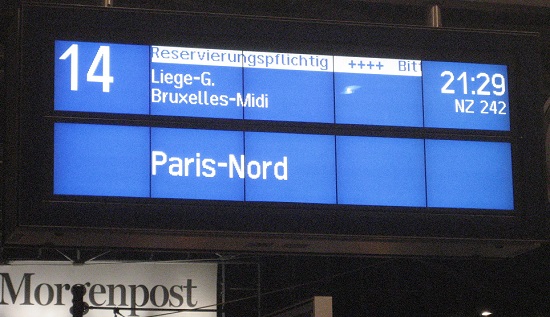
Direct trains between Berlin/Hamburg and France are history since 14 December 2014 (with the exception of the tricky-to-book RZD train between Berlin, Strasbourg and Paris), a gift for the airlines...
High-speed lines have the ability to shrink journey times significantly. But they can also introduce conflicts of interest and reduce choice, especially when the opening of new lines is accompanied by cuts to 'classic' services and international long-distance routes formerly operated under the EuroCity banner. This problem has affected routes to/from France and Belgium in particular, while the journey planner of the former is notorious in being programmed to offer TGVs via Paris when searching for cross-country journeys in southern France! Why is this? Operators want passengers to use high speed trains, in part to justify the construction of new lines and ensure high load factors on trains that are energy-greedy and expensive to operate. However, such trains can make more trips per day than slower trains over the same distance, reducing the number required. Management can be so preoccupied with the most profitable high speed services that classic routes are no longer marketed at best, or suffer 'death by a thousand cuts'. Provincial towns and cities away from the high speed network can be left with a significantly worse service. By removing choice, passengers are forced to go high speed (often at a much higher fare) or find an alternative mode.
Most high-speed trains in/to/from France, Spain and Italy are 'globally priced', jargon that means there are (i) limited or no through ticketing options, (ii) compulsory reservations and (iii) limited-quota and/or expensive supplements for rail pass holders. French TGVs are generally comfortable enough for journeys of up to 3 hours, but not for longer trips such as Paris - Italy/Spain. There is a general lack of regard for the needs of the (poorly studied) longer-distance market and passengers requiring flexibility in their travel plans, the latter being another example of rail squandering an inherent advantage over other modes...
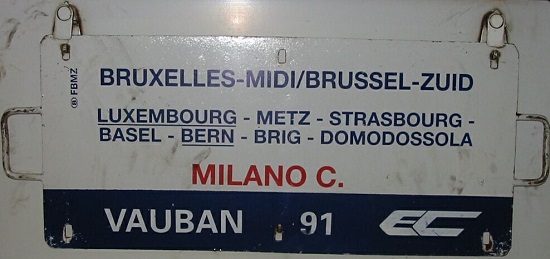 Destination board on a classic EuroCity train from Belgium to Italy. In recent years the route was decelerated and i) cut from 3 train pairs per day to 2; ii) cut back to run north of Zurich/Chur only; iii) cut back to end in Basel eastbound in December 2011; and iv) cut back to start westbound in Basel in December 2013. Comfortable Swiss rolling stock with laptop sockets were replaced by basic Belgian carriages in December 2013. French and Belgian Railways want to force passengers to use expensive TGV trains via Paris (a much longer route subject to global pricing and with awkward cross-Paris transfer). The two remaining Brussels - Basel direct services ran for the last time on 2 April 2016. This has left the Luxembourg - Basel route without direct trains.
Destination board on a classic EuroCity train from Belgium to Italy. In recent years the route was decelerated and i) cut from 3 train pairs per day to 2; ii) cut back to run north of Zurich/Chur only; iii) cut back to end in Basel eastbound in December 2011; and iv) cut back to start westbound in Basel in December 2013. Comfortable Swiss rolling stock with laptop sockets were replaced by basic Belgian carriages in December 2013. French and Belgian Railways want to force passengers to use expensive TGV trains via Paris (a much longer route subject to global pricing and with awkward cross-Paris transfer). The two remaining Brussels - Basel direct services ran for the last time on 2 April 2016. This has left the Luxembourg - Basel route without direct trains.
Operational constraints. Although high-speed lines can permit speeds as high as 320 km/h, time savings are often squandered by the need to change trains in places such as Brussels, Cologne, Frankfurt, Hendaye/Irun and Strasbourg. This is because high-speed trains tend not to be 'interoperable', and classic 200-230 km/h rolling stock is considered too slow for high-speed infrastructure (especially in France). Today there are no direct trains between Paris/Strasbourg and Hamburg, Prague and Vienna. What is the solution? We suggest the integration of timetabling and rolling stock concepts, such that international trains can be operated as extensions of core domestic fast trains and 'foreign' carriages can be used on domestic services, maximising resource efficiency. This is fundamentally incompatible with the current model of each operator specifying its own bespoke rolling stock, exacerbated by a fragmentation-driven increase in the number of players.
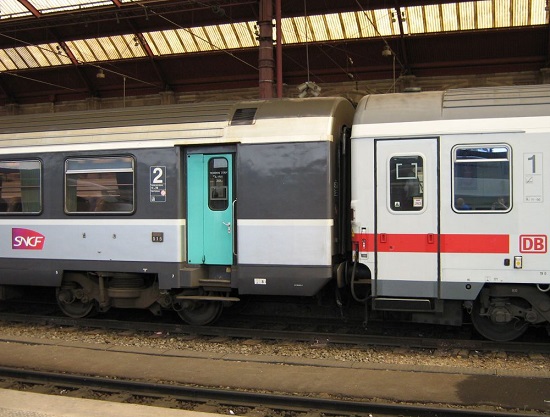 Cooperation and interoperability the traditional way! This Paris - Vienna day train (and its overnight counterpart) disappeared with the opening of the Ligne à Grand Vitesse (LGV) Est between Paris and Strasbourg. Such trains have fallen out of fashion in western Europe as they are generally limited to 200 km/h and cannot be used on French-style high-speed lines with special signalling, despite the otherwise 'go-anywhere', flexible and low-cost nature of the rolling stock. But many people prefer direct journeys rather than having to change several times and fight with the booking systems of multiple operators.
Cooperation and interoperability the traditional way! This Paris - Vienna day train (and its overnight counterpart) disappeared with the opening of the Ligne à Grand Vitesse (LGV) Est between Paris and Strasbourg. Such trains have fallen out of fashion in western Europe as they are generally limited to 200 km/h and cannot be used on French-style high-speed lines with special signalling, despite the otherwise 'go-anywhere', flexible and low-cost nature of the rolling stock. But many people prefer direct journeys rather than having to change several times and fight with the booking systems of multiple operators.
Best Practice
It's not all doom and gloom! Switzerland remains a beacon of sanity: per capita rail use is the highest in Europe despite the wealth of its citizens, near-universal car ownership, an absence of high-speed lines and little liberalisation of passenger services. Switzerland's unwaving political commitment to a sustainable transport system, long-term planning horizons, timetable and capacity optimisation and targeted infrastructure improvements are a model for the rest of the world to copy. A ticket can be purchased from any public transport stop to any other, regardless of the number of operators used. A ticket valid on all modes for one year can be purchased for around 3000 EUR. Cooperation and integration are at the heart of the Swiss public transport philosophy. While retaining some commercial freedom, Swiss Federal Railways (SBB) has a brief to maximise rail mode share and accessibility to, from and within the country. This is in stark contrast with the narrow aim of profit maximisation on selected corridors seen elsewhere. SBB retains good relations with its neighbours, as there are few if any competition-related conflicts. Local cross-border routes to Austria, Germany and Italy are well integrated into the national system.
Elsewhere in Europe regional cross-border routes/networks have been successfully tendered, and a handful of trans-European long-distance routes and ticketing schemes remain. Examples can be found in Appendix III of WCN's open letter to the European Commission.
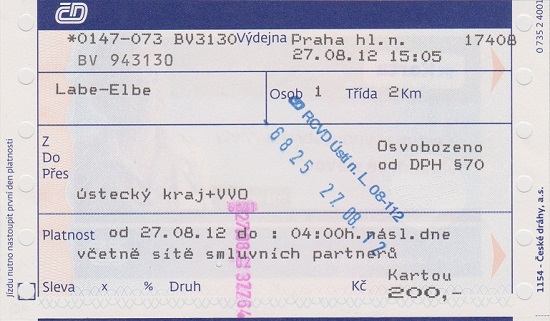
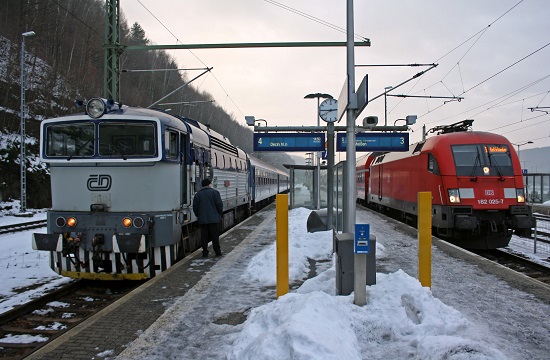 Positive examples do exist! Local authorities in the Germany/Czech Republic border regions in particular have worked hard to offer attractive timetables and integrated ticketing. In this example there is cross-platform interchange and a short wait between a local train from Dresden and a regional cross-border service to Dečin. We welcome competitive tendering for the operation of publically-specified regional routes, provided that the railway still functions as an integrated system.
Positive examples do exist! Local authorities in the Germany/Czech Republic border regions in particular have worked hard to offer attractive timetables and integrated ticketing. In this example there is cross-platform interchange and a short wait between a local train from Dresden and a regional cross-border service to Dečin. We welcome competitive tendering for the operation of publically-specified regional routes, provided that the railway still functions as an integrated system.
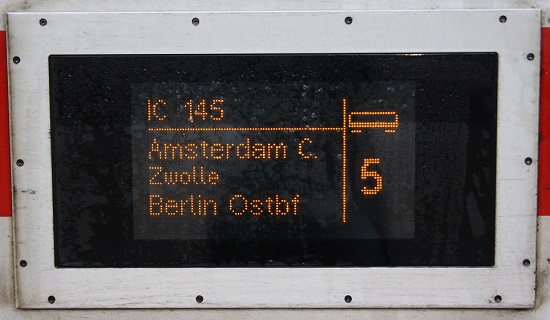
Another survivor and another example of traditional cooperation with interoperable rolling stock! Yes, it takes 7 minutes to change locomotives at the border, but passengers enjoy comfortable and spacious carriages and a reliable service. Why sacrifice that for the sake of 7 minutes?
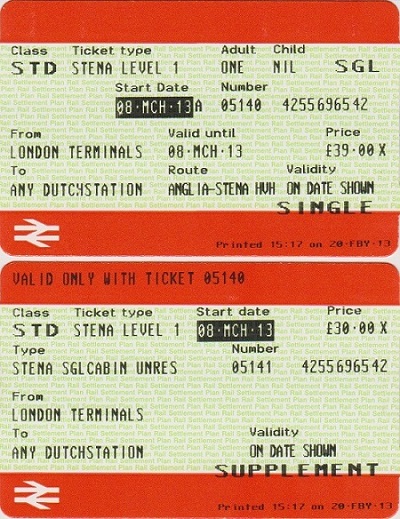
One ticket and no stress when travelling between the south of England and the Netherlands via the Harwich - Hoek van Holland ferry. This is now the only properly integrated Rail & Sail route between the UK and continental Europe. We hope it will survive the threatened conversion of the Hoek van Holland to Rotterdam line into a metro...
What Should Be Done?
WCN has set out a number of solutions that require the will of the European Commission in particular, but also national governments and/or rail operators to implement:
Short-term goals:
- A body at European level (the Commission or its agency ERA) should participate pro-actively in the international timetable negotiation process, acting principally to discourage needlessly poor/broken connections. This is not a technological problem!
- High track and station access charges are stifling growth and threatening marginal routes. The European Commission should urgently review and mitigate the negative consequences of the requirement for operations and infrastructure management to be separated beyond the level of accounting transparency. Stronger regulation is likely to be necessary.
- The European Commission and partners such as UIC/CER should disseminate best practice in the financing and operation of international passenger trains, through high-level conferences and publications.
- The European Commission should support the development of online and printed "Man in Seat 61"-type information resources in all Member States, in order to provide impartial expert advice on international surface travel in an easy-to-understand way.
Short- to medium-term goals:
- The European Commission and European financial institutions such as the EBRD should consider broad transport mode share and environmental policy goals first and foremost when assessing applications for infrastructure co-funding. Financial institutions' demands for public sector spending cuts must also consider these over-arching long-term objectives. Rules on the use of co-financed infrastructure should be enforced and/or strengthened, such that Member States cannot withdraw (e.g. Greece) or simply not provide (e.g. Danube Bridge 2, etc) passenger rail services on lines recently built/upgraded with European money.
Medium-term goals:
- Train operators should rethink their strategy in order to attract more business on routes of > 4 hours travel time. Direct trains, optimised connections, through ticketing and good on-board facilities (WiFi, comfortable seating in a variety of business- and group-friendly layouts, catering) can attract and retain passengers. Consideration should be given to retrofitting classic trains with the equipment needed to use high-speed lines at 200-230 km/h. Cramped, poorly connecting and globally-priced trains simply encourage or force long-distance travellers to use alternatives.
- The European Commission should take the lead in pushing for the implementation of 'user pays' and 'polluter pays' principles with regard to road use and flights.
- The European Commission and both EU and non-EU countries should research, plan and - where necessary - co-finance the operation of cross-border rail routes to fill gaps in the passenger rail network. Public service obligations (PSOs) and competitive tendering are possible solutions.
- The European Parliament and Commission should prepare legislation to oblige passenger train operators to sell and accept through tickets for journeys involving more than one operator. This might well require the establishment of systems such as the Rail Settlement Plan used in the UK. If this is not possible, the Commission should take the lead in developing/procuring an independent, impartial and free-to-use trans-European booking service. In addition, legislation on passenger rights should be updated to reflect the fragmented nature of the railway in many parts of Europe, in particular journeys made using combinations of two or more tickets.
Long-term goals:
- The Commission should take the lead in the development of an integrated, regular-interval long-distance trans-European passenger train network, rather than applying the TEN-T corridor-based approach that is better suited to freight. There should be greater emphasis on planning and funding operations rather than capital expenditure on infrastructure.
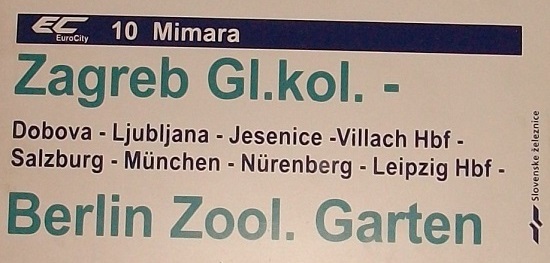
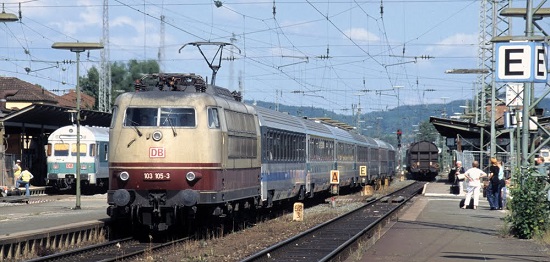
The 'Mimara' offered a direct and comfortable direct link from Berlin to Zagreb until the year 2000, and was fully integrated into the German InterCity/InterRegio network that has since contracted substantially. Today there is no suitable 'carrier' train for the carriages within Germany. As a consequence you have to change once or twice and journeys are longer despite the use of a shorter, faster route in Germany.
Lower image courtesy of Peter Biewald.
Action Taken by WCN
WCN launched an online petition against Croatian Railways in November 2012 in response to its plans to cut almost all international trains. This pressure helped to save 12 out of the 44 daily trains listed for withdrawal.
This was followed up with an open letter to the European Commission's Transport Commissioner and the Director General of DG-MOVE (the EC's Transport and Mobility wing). This explains the problems, provides detailed lists of recent line closures and timetable cuts, and outlines WCN's suggestions to improve the situation in the short-, medium- and long-term. We found the Commission's reply unacceptable, since it fails to acknowlege its role in creating some of the problems and possibly mitigating them in the future. Instead, the Commission continues to pursue (i) 'vertical separation' of infrastructure and operations, and (ii) expensive, disruptive technological solutions as virtuous policy objectives rather than means to a particular end. Yet these goals are likely to exacerbate rather than solve the problems of fewer direct trains, poor connections and fragmented ticketing...
In response WCN has teamed up with Michael Cramer MEP to try to get proper answers out of the European Commission. Why have EU infrastructure funds been repeatedly mis-spent, and why is the EC's rhetoric on seamless mobility (one journey, one ticket, etc) not matched by legislation to preserve through ticketing and passenger rights when using multiple operators? Michael is assisting us by asking questions in the European Parliament.
World Carfree Network continues to monitor the situation and will bring you updates here and via the Back on Track mailing list.
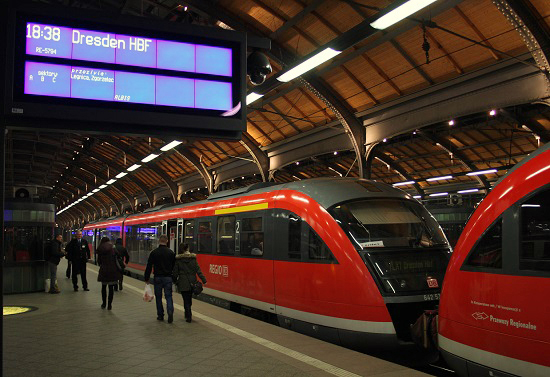
Services between Wrocław (Poland) and Dresden (Germany) were withdrawn with little warning from 1 March 2015, a victim of a host of financial and organisational problems, leaving the cross-border section over the River Neisse without any passenger trains at all and creating a new gap between the German and Polish passenger networks. Services were restored with a different operator in Poland from 13 December 2015.
Further Information
Questions, comments and your own examples of good and bad practice in cross-border railways are welcomed by e-mail to
, WCN's Back on Track Campaign Co-ordinator.
You can also join the Back on Track mailing list.
Written Questions in the European Parliament
Note that parliamentary questions are generally posed by elected Members of the European Parliament and directed at the European Commission (the EU's unelected executive agency). You can judge the quality of the answers for yourself!
Related Links
|
![[Home]](http://worldcarfree.net/img/logo1.jpg)




![[Home]](http://worldcarfree.net/img/logo1.jpg)






